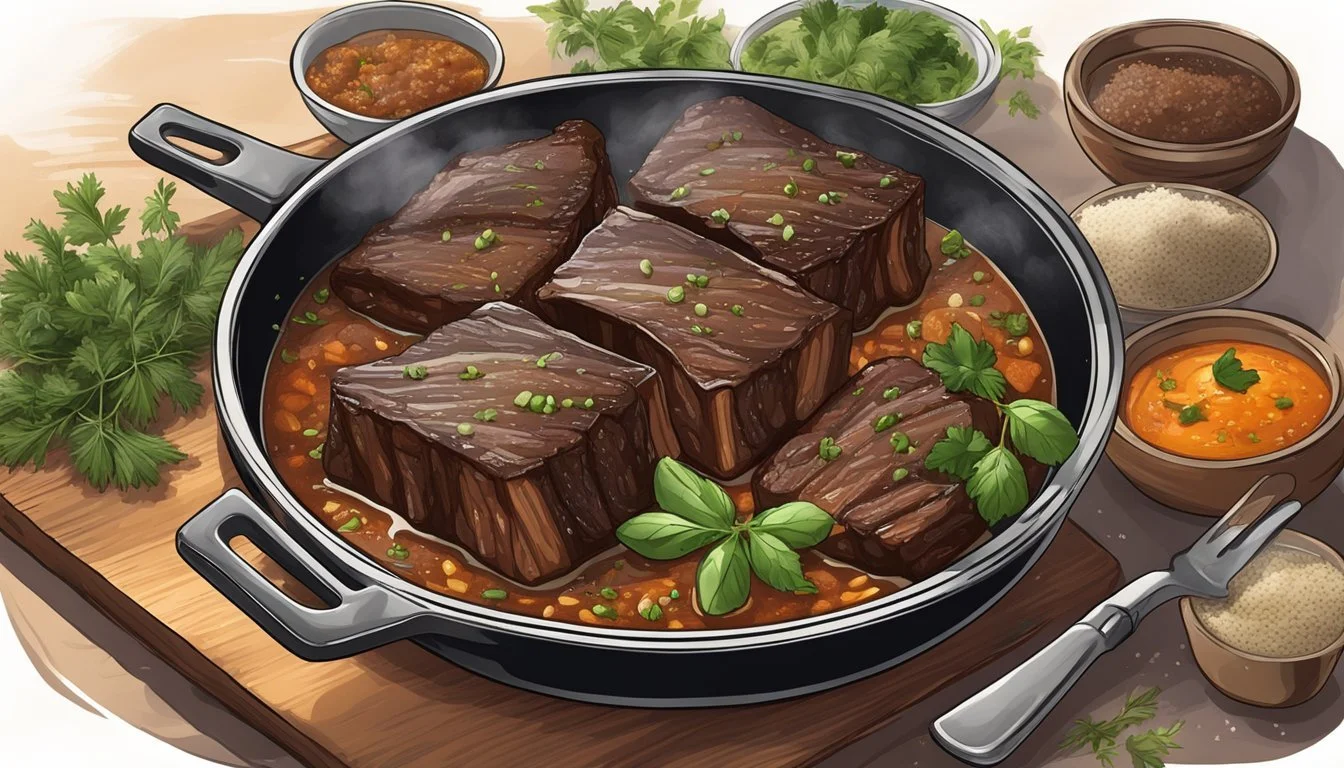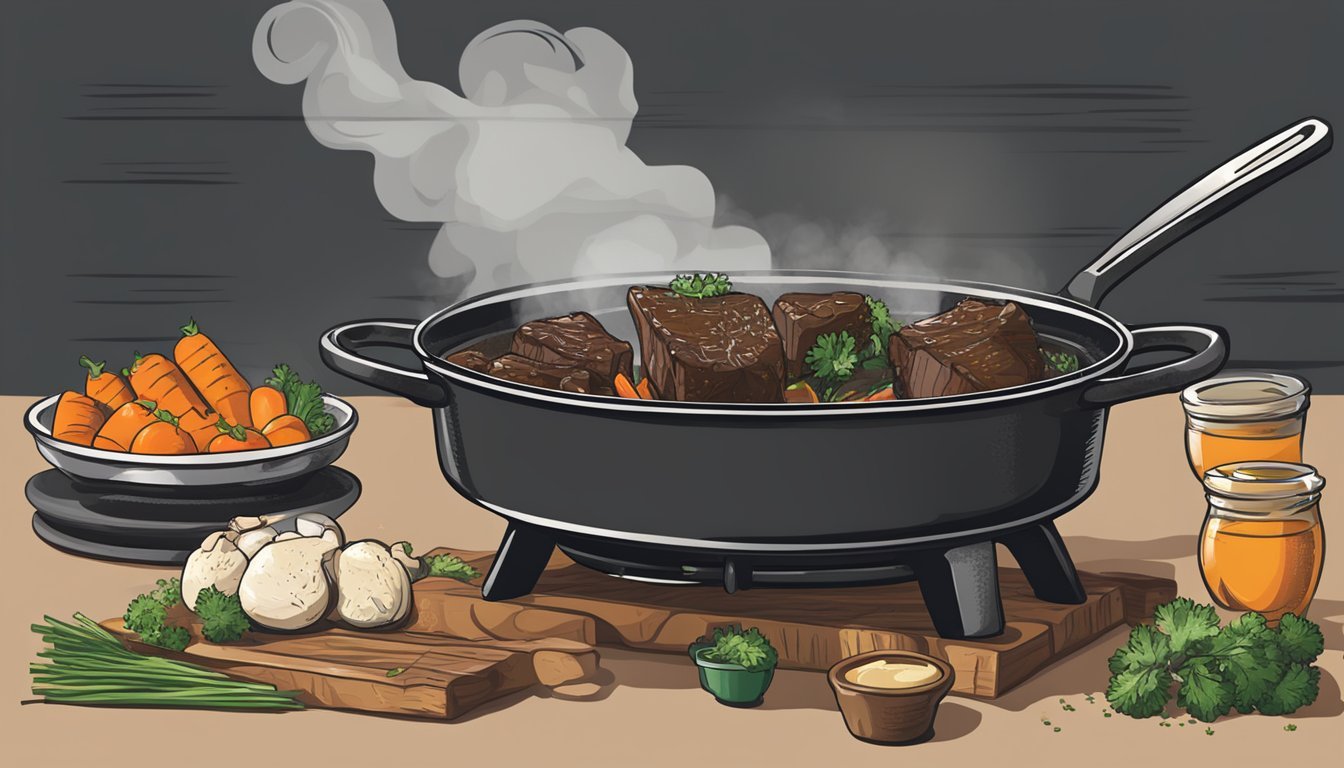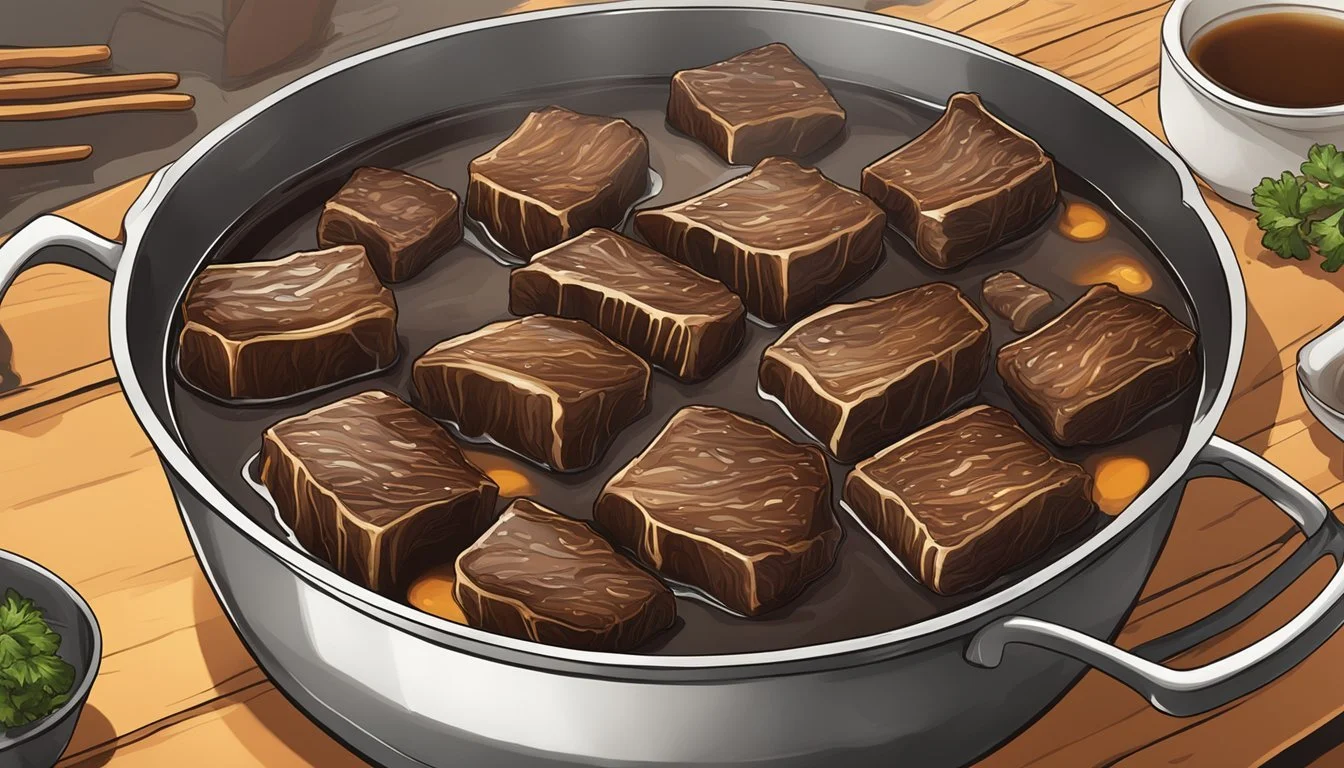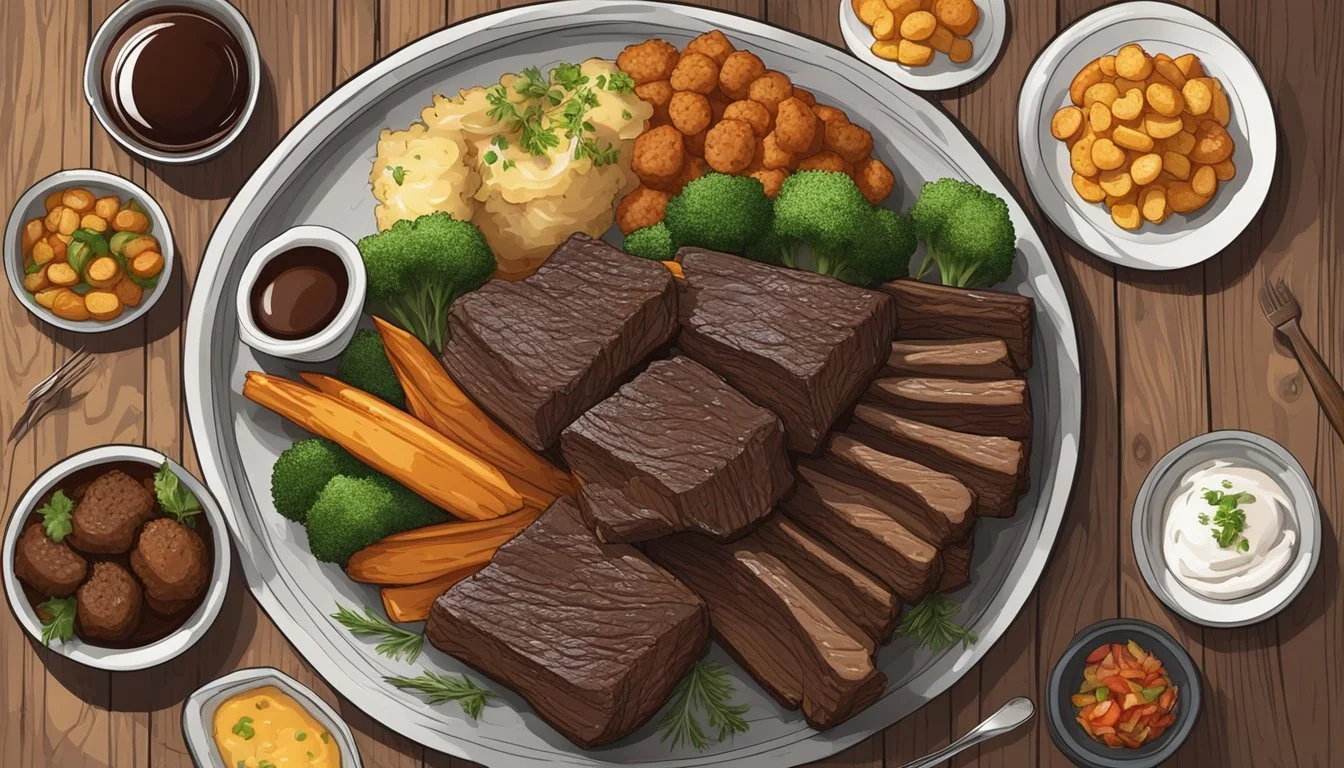Beef Short Ribs
Beef (What wine goes well with beef?) short ribs are a popular, protein-rich dish known for their distinctive flavor and tender texture. Often associated with comfort food, these succulent cuts of beef are widely enjoyed by many for their mouth-watering taste. Consisting of a short portion of the rib bone covered in meat, beef short ribs (What wine goes well with beef short ribs?) offer a satisfyingly filling meal option that can be prepared in various ways, such as being slow-cooked, barbecued, or braised.
A familiar staple in many cultures, beef short ribs offer a versatile choice for home cooks and professional chefs alike. Given the range of culinary techniques that can be applied to this flavorful cut, it's no wonder that beef short ribs have earned their place as a desirable dish for countless gatherings and family meals. In addition to their indulgent taste, these ribs are packed with protein, making them a nutritious choice for those looking to incorporate more protein into their diets.
When it comes to ribs recipe, quality is key. By choosing high-quality cuts of meat with good marbling and rich color, diners can enjoy a more delectable and tender dish. To make the dish even more flavorful, you can try using cups beef broth (how long does beef broth last?) or beef stock in your recipe. Season with salt and cook it for the right amount of cook time and you'll be left with an amazing recipe that's perfect for any special occasion. To keep it fresh and ready to eat later, store it in an airtight container. For additional flavor, try adding medium onions to your recipe. This delicious dish will surely impress your guests!
Selecting Quality Beef Short Ribs
Bone-In vs Boneless
When it comes to beef short ribs, there are two primary options to choose from: bone-in and boneless. Bone-in short ribs have the rib bone still attached to the meat, while boneless short ribs have the bone removed.
Some people prefer bone-in short ribs for their rich flavor, as the bones impart a deeper taste during the cooking process. Additionally, bones help to retain moisture in the meat, resulting in a juicier and more tender eating experience. However, bone-in short ribs tend to be larger and may require more cooking time.
On the other hand, boneless beef short ribs are more convenient and easier to work with, as there is no need to navigate around the bones during preparation or eating. Despite the absence of the bones, they can still yield a flavorful result, particularly when cooked for a prolonged period.
It ultimately depends on individual preference, as both bone-in and boneless short ribs offer their unique qualities.
Marbling and Meat Quality
To select the best beef short ribs, it is important to assess the meat's marbling - the dispersion of fat within the muscle. Ideally, the ribs should be marbled with fat evenly throughout the meat, resulting in tender and flavorsome bites after cooking.
To make an informed choice, consider the following marbling-to-quality ratio table:
Quality Level: Prime
Fat Marbling: High
Description: Excellent marbling, producing the most tender and flavorful meat.
Quality Level: Choice
Fat Marbling: Moderate
Description: Good marbling, resulting in tender and tasty meat.
Quality Level: Select
Fat Marbling: Low
Description: Limited marbling, leaner and not as tender.
A higher marbling level usually corresponds to higher-quality meat. Prime and choice cuts are recommended, as they possess a good balance of marbling and tenderness. Avoid select cuts, as their limited marbling results in a less tender and less flavorful dish.
Selecting quality beef short ribs depends on personal preference between bone-in and boneless options, while also considering the level of marbling for better texture and flavor. By paying attention to these factors, you can ensure the beef short ribs you choose meet your desired standards.
Essential Ingredients
When preparing beef short ribs, the essential ingredients are key to making the dish flavorful and succulent. In this section, we will discuss the herbs and spices as well as the vegetables that are required for braising the short ribs.
Herbs and Spices
To perfectly season beef short ribs, a combination of several herbs and spices will do the trick. The must-have ingredients include:
Kosher Salt (how long does kosher salt last?) or Salt of choice: Enhances the natural flavors of the beef and plays a crucial role in the overall taste.
Black pepper: Provides a balanced heat to the dish and accents other flavors.
Fresh Rosemary: This aromatic herb adds a distinct, pine-like aroma to the dish, complementing the natural flavors of the beef.
Garlic: Adds a robust, unmistakable flavor that permeates the dish and adds depth.
Trust me, the easiest way to buy kosher salt and black pepper is through online retailers!
Here is a simple table to show the recommended quantities for a serving of four beef short ribs:
Salt: 1 tablespoon
Black pepper: 1/2 tablespoon
Rosemary: 2 sprigs, fresh
Garlic: 4-5 cloves, minced
Vegetables for Braising
The braising process is essential to transform beef short ribs into a tender and succulent dish. To ensure optimal outcomes, the use of these vegetables leads to a tastier result:
Yellow Onions: Providing a subtle sweetness and depth while cooking, onions are essential in the braising process.
Carrots (how long do carrots last?): Another sweet component, carrots add both texture and flavor to the dish.
Olive oil: As a healthier alternative to other oils, this ingredient helps to brown the meat and sauté the vegetables.
When it comes to olive oil, online shopping is the way to go!
The following list details the recommended quantities for these vegetables:
1 large onion, chopped
2 medium carrots, chopped
2 tablespoons of olive oil
Incorporating these essential ingredients in the appropriate quantities ensures a scrumptious and satisfying beef short ribs dish.
Preparation Techniques
Trimming Excess Fat
Before cooking beef short ribs, it's essential to trim any excess fat. While some fat is necessary for a rich flavor and tender texture, too much can result in a greasy final product. To properly trim the short ribs:
Use a sharp knife to remove any large, visible pieces of fat
Keep an eye out for silver skin (a tough, thin membrane) and remove if possible
Aim for a consistent layer of fat no thicker than 1/4 inch
Remember, a little fat goes a long way in enhancing the taste and mouthfeel of beef short ribs!
Searing for Flavor
The secret to delicious beef short ribs is achieving a rich, brown crust through searing. Searing not only enhances the flavor but also enriches the color, making for an appealing presentation. Here's how to perfect the searing process:
Heat oil: Choose a high smoke point oil such as vegetable or canola oil. Add a small layer to a heavy-bottomed skillet (preferably cast iron) and heat over medium-high.
Season and coat: Lightly season the short ribs with salt and pepper. To prevent sticking and encourage even browning, you may also opt to lightly coat the ribs in flour (how long does flour last?), shaking off any excess.
Sear: Carefully place the ribs in the hot oil, making sure not to overcrowd the skillet. A good rule of thumb is to leave about 1 inch of space around each rib. Sear each side until deeply browned, about 2-4 minutes per side.
Sauté: Once all sides are seared, you might also sauté some aromatics such as garlic, onions, and carrots in the same skillet to add depth and dimension to the overall dish.
Take time to perfect the searing process for truly flavorful and succulent beef short ribs that will have everyone asking for seconds!
Discover the endless possibilities of buying skillet, vegetable, or canola oil online!
Cooking Methods
Oven Braising
Oven braising is a popular method of cooking beef short ribs. By cooking low and slow, the tough connective tissues in the ribs are broken down, resulting in tender, flavorful meat. To oven braise, preheat your oven to 300°F (150°C) and follow these steps:
Heat a Dutch oven or a heavy-bottomed oven-safe pot with a tight-fitting lid on the stovetop.
Season the ribs with salt and pepper, then brown on all sides.
Remove the ribs, and add your choice of aromatics (e.g., onions, garlic) to the pot.
Deglaze with a liquid (e.g., wine, stock), then return the ribs to the pot.
Add enough liquid to cover at least half of the ribs, then cover with the lid.
Place the pot in the preheated oven, and cook for 2.5 to 3 hours, or until the meat is fork-tender.
Online stores offer unbeatable prices for a Dutch oven, so don't miss out!
Slow Cooker
Using a slow cooker is another excellent method for cooking beef short ribs. The low and slow cooking process ensures tender results and retains the natural flavors of the meat. Here’s a simple process to follow:
Season the ribs and brown them in a skillet.
Transfer the ribs to the slow cooker.
Add aromatics (e.g., onions, garlic) and liquid (e.g., stock, beer) to the slow cooker.
Set the slow cooker to low heat and cook for 8 hours.
The slow cooker method requires less attention than oven braising, making it convenient for busy weekdays.
Pressure Cooking
For a quicker cooking option, consider using a pressure cooker. This method reduces the cooking time significantly while still yielding tender and flavorful beef short ribs.
Season and brown the ribs in the pressure cooker using the sauté function.
Add your choice of aromatics (e.g., onions, garlic) and liquid (e.g., broth, wine) to the pressure cooker.
Secure the lid and set the pressure cooker to high pressure.
Cook for approximately 45 minutes.
Carefully release the pressure according to the manufacturer's instructions before opening the pressure cooker.
This method is perfect for those who want delicious beef short ribs in a fraction of the time traditional methods require.
Flavorful Braising Liquids
Braising liquids are essential for enhancing the flavor of beef short ribs and achieving a tender, delicious finish. In this section, we'll explore red wine-based and stock varieties of braising liquids that work well with beef short ribs.
Red Wine Based
Red wine is a popular choice for braising beef short ribs due to its rich, bold flavors that complement the meat. A classic red wine sauce is commonly used, combining red wine with ingredients like tomato paste (how long does tomato paste last?) and Worcestershire sauce (how long does worcestershire sauce last?) to add depth and complexity to the dish.
Here's a simple recipe to create a red wine-based braising liquid:
In a large skillet, heat 2 tablespoons of olive oil over medium heat.
Add 1 chopped onion, 2 minced garlic cloves, and 1 diced carrot to the skillet, cooking until the vegetables are softened.
Stir in 1 cup of red wine, 2 cups of beef stock, 1/4 cup of tomato paste, and 2 tablespoons of Worcestershire sauce.
Bring the mixture to a boil, then let it simmer for about 10 minutes to allow the flavors to meld.
You can then pour this braising liquid over the beef short ribs in a slow cooker or Dutch oven and cook until the meat is tender.
Experience the convenience and savings of buying beef stock, tomato paste, and Worcestershire sauce online!
Stock Varieties
Beef stock is another excellent option for a braising liquid, as it contributes to a savory, rich flavor and pairs well with beef short ribs. Several variations of beef stock-based braising liquids can be customized based on personal taste or available ingredients.
Here are some key ingredients that can be included in beef stock-based braising liquids:
Beef stock
2-3 cups
Provides a rich, savory base for the liquid
Tomato paste
1/4 cup
Adds thickness and depth to the flavor
Worcestershire sauce
1-2 tablespoons
Gives a tangy, umami element to the braising liquid
Soy sauce (how long does soy sauce last?)
1-2 tablespoons
Enhances the savory, umami flavor
Fresh herbs
To taste
Offers an aromatic touch to the dish
To create a braising liquid using these ingredients, simply combine them in a saucepan and simmer for about 10 minutes before pouring them over the beef short ribs to braise.
Remember that the braising liquid plays a crucial role in cooking beef short ribs, imparting flavors and tenderness that make this dish truly delectable. Using red wine-based liquids or stock varieties can lead to a satisfying and flavorful meal that everyone will enjoy.
Creating the Perfect Sauce
Reduction Techniques
Achieving the perfect sauce to accompany beef short ribs starts with mastering reduction techniques. A good reduction concentrates flavors while thickening the sauce to the desired consistency. Begin by simmering your sauce ingredients in a saucepan, allowing the liquid to evaporate slowly. This process not only intensifies flavors but also reduces the amount of sodium and sugar present in the final product. Keep the heat low and remember to stir occasionally to prevent any scorching.
Format tip: Choose a wide saucepan to maximize surface area and expedite the reduction process.
Seasoning and Thickening
Once your sauce has reduced, it's time to focus on seasoning and thickening. The foundation of any great sauce or gravy starts with a roux. To create a roux, combine equal parts of all-purpose flour and butter in a saucepan. Cook this mixture over medium heat, stirring constantly until it reaches a golden brown color. The roux not only thickens the sauce but also provides a velvety texture and rich flavor.
Common seasonings to add include salt, pepper, herbs, and spices. Keep the amount of salt in check to maintain a balanced level of sodium in the sauce.
Thickening techniques:
Roux (all-purpose flour + butter): The classic method, providing both thickness and flavor.
Cornstarch (how long does cornstarch last?) slurry: Mix equal parts cornstarch and cold water, then stir into the sauce until the desired consistency is achieved. This method is gluten-free and offers a glossy appearance.
Remember to taste and adjust seasonings as needed. It's essential to strike a balance between richness, acidity, and sweetness to complement the beef short ribs.
Mastering reduction techniques, seasoning, and thickening will help you create the perfect sauce to elevate your beef short ribs dish. By paying attention to details like sodium levels, sauce consistency, and flavor balance, your sauce will enhance—not overpower—the succulent flavors of the meat.
Side Dishes
Starch Options
A delicious and satisfying side dish for beef short ribs can significantly enhance the dining experience. Two popular starch options are mashed potatoes and polenta (how long do polenta last?).
Mashed Potatoes: Creamy and smooth, mashed potatoes make the perfect accompaniment to beef short ribs. They absorb the rich sauce from the ribs and provide a comforting texture. To prepare, simply boil potatoes until tender, then mash with butter, cream, salt, and pepper.
Polenta: This Italian staple is a great alternative to mashed potatoes. Made from coarsely ground cornmeal (how long does cornmeal last?), polenta offers a creamy, yet slightly grainy texture that pairs well with the tender beef short ribs. Cook the polenta with butter, grated Parmesan, and chicken broth for an extra burst of flavor.
Vegetable Accompaniments
Incorporating vegetables into the side dishes not only adds variety to the meal but also offers nutritional benefits. Consider pairing beef short ribs with carrots or other root vegetables to create a well-rounded dish.
Carrots: These vibrant orange vegetables make an excellent side dish when they are roasted, glazed, or simply sautéed. They deliver a pop of color and natural sweetness that complements the richness of the beef short ribs. For an effortless side, try tossing some baby carrots in olive oil, salt, pepper, and fresh thyme, then roast until tender.
Root Vegetables: Venture beyond carrots and explore other root vegetable options, such as turnips, parsnips, or beets, for a unique accompaniment to beef short ribs. Roasting a mixture of these vegetables with olive oil, salt, pepper, and your choice of herbs will create a medley of flavors and textures that perfectly complement the succulent ribs.
Balancing beef short ribs with delicious and nutritious side dishes elevates the overall dining experience. Whether it's the comforting creaminess of mashed potatoes or polenta or the colorful array of vegetable accompaniments, these side dish options ensure a memorable and satisfying meal.
Nutritional Information
Counting Calories and Macros
Beef short ribs, as a meat source, come packed with a significant amount of calories and macronutrients. Here's a breakdown of the nutritional content for a 100g serving of beef short ribs:
Calories: 303 kcal
Protein: 20g
Total Fat: 24g
Saturated Fat: 10g
Carbohydrates: 0g
Fiber: 0g
From this table, it's clear that beef short ribs are high in calories and fat, making them a rich and indulgent choice of protein. They also contain a moderate amount of protein, but no fiber or carbohydrates.
Understanding Vitamins and Minerals
In addition to calories and macronutrients, beef short ribs also provide several important vitamins and minerals. Here is a list of some key nutrients found in a 100g serving of beef short ribs:
Vitamin A: 0% of daily value
Vitamin C: 0% of daily value
Calcium: 2% of daily value
Iron: 9% of daily value
Potassium: 255mg (7% of daily value)
While beef short ribs are not a significant source of vitamin A or vitamin C, they do contain a decent amount of iron and potassium. Iron is crucial for maintaining healthy blood cells and oxygen transport, while potassium plays a role in muscle and nerve functions, as well as blood pressure regulation.
Beef short ribs can be a tasty and indulgent protein choice, with notable iron and potassium content. However, due to their high calories and fat content, it's important to consume them in moderation as part of a balanced diet.
Serving and Presentation
Plating Techniques
When serving beef short ribs, it is crucial to focus on presenting the dish appealingly. Before beginning, ensure the ribs are fork-tender by testing with a fork; the fork should slide in and out easily. To emphasize the ribs' succulent appearance, try to place them on the plate in an attractive arrangement. For instance, you can stack the ribs on top of each other or lay them out side by side.
You can enhance the visual appeal by placing a side dish next to the ribs, like mashed potatoes or polenta. Alternatively, spoon the sauce or cooking liquid over the ribs to evenly cover them. To boost the dish's elegance, consider using a serving platter for a larger yield and arrange the ribs in a circular pattern on the rim, with the side dish in the center.
Garnishing for Aesthetics
A visually appealing garnish, such as a rosemary sprig, can heighten the overall presentation of your beef short ribs. For additional color, consider incorporating ingredients like:
Chopped parsley
Color Effect: Vibrant green
Sliced green onions
Color Effect: Mild green
Orange or lemon zest (how long does lemon zest last?)
Color Effect: Bright and contrasting
Distribute your chosen garnish evenly over the ribs for a consistently appealing display. Keep in mind that your garnish should not only be aesthetically pleasing but should also enhance the flavor of the dish. Ultimately, a thoughtful presentation of beef short ribs can create an enjoyable, memorable dining experience.
Engaging with the Community
Social Media
The beef short ribs community is active and thriving on various social media platforms. It's essential to engage with fellow enthusiasts and share information, tips, and mouth-watering pictures. Let's explore some of the popular platforms:
Facebook: Join specific groups dedicated to beef short ribs or general cooking communities. These groups often share recipes, cooking techniques, and pairing suggestions.
Pinterest: A haven for food lovers, Pinterest is an excellent platform to find and share beef short rib recipes. Users can create boards and pin their favorite dishes, allowing others to discover new ideas.
Instagram: As a visually-driven platform, Instagram provides a great opportunity to showcase delicious beef short rib creations. Following and engaging with chefs, restaurants, and fellow cooks can lead to incredible inspiration.
Newsletter: Many culinary websites, chefs, and food bloggers offer newsletters to subscribers. These newsletters often contain exclusive recipes, cooking tips, and community events related to beef short ribs.
Frequently Asked Questions
Addressing common queries and concerns helps the beef short ribs community grow and learn collectively. Below are some frequently asked questions:
What's the best cut for beef short ribs? There are several cuts of beef short ribs, the most popular being the English cut and the Flanken cut. Both cuts cook differently and have unique textures and flavors.
How do I cook beef short ribs? Cooking methods include braising, slow-cooking, grilling, and smoking. Each technique offers a distinct flavor profile and texture to the short ribs.
What are the best seasonings for beef short ribs? Seasonings can vary depending on personal preference. Some popular options are salt, pepper, garlic, onion powder (how long does onion powder last?), paprika, and thyme. Don't be afraid to experiment with your favorite spices and herbs.
Connecting with fellow beef short rib enthusiasts, sharing recipes and experiences, and addressing frequently asked questions are excellent ways to engage in the community. Embracing the power of social media, utilizing platforms like Facebook, Pinterest, Instagram, and newsletters, can truly build and support the collective passion for beef short ribs.










